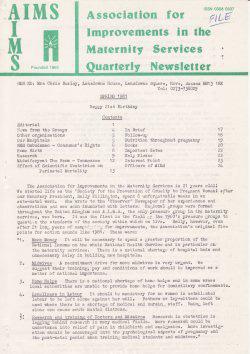
4 minute read
AIMS during the 1980s
from AIMS Journal, Vol 32 No 3 AIMS at 60 Making a difference past and future
by AIMS (Association for Improvements in the Maternity Services)
by Verina Henchy, AIMS Trustee
I was delighted to hear that the theme for this Journal is to look back over a 60 year history of maternity services, seen through the eyes of our service users and journal contributors. My eldest child was born in 1981 and it was particularly interesting for me to look at this year to see if the AIMS Journal of this time was reflective of my own experience of birthing in the early 80s.
Advertisement
Looking at the quarterly Newsletter for Spring 1981, the first thing that I notice is that AIMS is the same age as me! As AIMS was celebrating its 21st birthday, I was heavily pregnant with my first born, feeling pretty unprepared for motherhood and with very little thought for the birthing process to be honest! Are young people more prepared today I wonder? There is certainly much more media coverage of birth these days but the mainstream images frequently portray birth as something to be feared, something to be medically managed, something that creates a certain amount of panic and alarm! In the year 2020, images of positive birth and a narrative that supports empowerment and fulfilment can at least be found if you want to go looking for it and there are literally dozens of books on the market to help you to prepare for a positive birthing experience. How does this varied diet of information influence us I wonder and was my own somewhat restricted diet a bonus or a disadvantage? Sadly, I didn’t know about AIMS in those days but I did attend NCT classes which made me “a bit of a hippy” in the eyes of many at that time! I personally believe that knowledge is power and that access to information about birth and our maternity systems is important. I think that my own experiences would have been quite different if I had entered the ‘birth room’ with the
knowledge that I hold now. The main headline that caught my eye in the Summer 1981 Journal was “Ultrasound: Watching Babies Grow”.
When I was pregnant in 1981, one scan was routinely offered to all pregnant women and people and my understanding at the time was that it was simply offered to “count the number of babies”! A friend had recently birthed twins which had come as a complete surprise to her. Watching

her struggle up the street with her double pram with three relatively young siblings in tow, I was relieved to at least eliminate the risk of surprise twins and do not remember having any other benefits (or risks) mentioned.
The 1981 Journal article, it was reported that, “ultrasound scanning is rapidly becoming the norm, including repeated scans to closely follow a baby’s growth. Debates about the merits of this trend are beginning to surface, both because of the possible hazards and for its social implications - the necessary centralisation of antenatal services in high-technology centres, and the effect on people’s attitude to the normality of pregnancy and birth”.

The journal reported a series of letters in the Guardian (May 1981) that had raised the issue of safety of ultrasound for an unborn baby. Jean Robinson of the Patients Association had raised concerns that ultrasound might damage a baby’s central nervous system and this had been strongly refuted by Peter Scanlon (paediatrician).
Jean Robinson noted various reports of harmful effects of ultrasound exposure and directed readers to a report by an FDA researcher into ultrasound effects (Birth and the Family Journal, Summer 1980). She quoted FDA warnings about ultrasound safety and suggested that, “women should not be told that ultrasound is unequivocally safe, and that its use should be reserved for cases where essential diagnostic information cannot be gained by other means”.
The Journal article discussed some of the merits of ultrasound as claimed by physicians and explored specific and general risks to women, concluding that, ‘One is led to questions about the social management of pregnancy and childbirth’.
A midwife’s skilful hands can feel a baby’s position, and can monitor a baby’s growth, week by week. An attuned ear with a simple metal trumpet can hear a baby’s heartbeat. A mother can bond to her unborn baby by tuning in to its movements and rhythms; by recognising the validity of her own sensations. These are the skills and potentials that are not to be taken lightly, and that need not be sacrificed for the lure of still more sophisticated technology.
My second child was born in 1984 and interestingly, the front page of the Summer 1984 Journal was also an article on Ultrasound. The headline on the front page read, Ultrasound ‘We’re Beginning to see the signs of Danger, warning signs that in the past predicted medical disaster’, (Jean Garner, CNN Programme, 30th April 1982).
Beverley Ann Beech wrote in this journal:
The Association is most concerned that routine ultrasound is being carried out on large numbers of women; that no records are kept of the levels and occasions of these exposures; and that no long-term studies of the possible effects of ultrasound are being carried out... There is no evidence to support the claim that ultrasound is safe and the evidence that it may cause ill effects is still inadequate. This lengthy (3 page) article set out the arguments and concerns in true AIMS fashion, citing dozens of articles and scientific papers along with details of the considerable amount of correspondence that had been generated as part of the AIMS campaign for safety in maternity care. 35 years later, In July 2016, Dr Sarah Buckley revisited these questions in her article, Ultrasound Scans in Pregnancy









